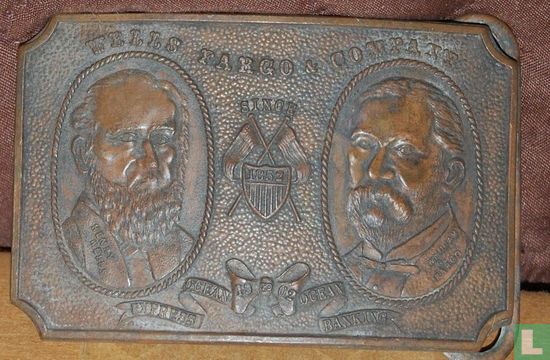Enlarge image
USA Wells Fargo & Company 1850-1902
Catalogue information
LastDodo number
6930149
Area
Tokens / Medals
Title
USA Wells Fargo & Company 1850-1902
Publisher
Value
Country
Year
1902
Collection / set
Material
Weight
Variety / overstrike
Obverse
Wells Fargo & Company / Since 1852 / Henry Wells, William G. Fargo / 1902 / Ocean Express, Ocean Banking
Reverse
Privy mark
Mint mark
Designer
Engraver
Dimensions / Diameter
90 x 60
Number
Details
The name Wells Fargo is forever linked with the image of a six-horse stagecoach thundering across the American West, loaded with gold. The full history, over more than 160 years, is rich in detail with great events in America’s history. From the Gold Rush to the early 20th Century, through prosperity, depression and war, Wells Fargo earned a reputation of trust due to its attention and loyalty to customers.
In 1852, Henry Wells and William Fargo founded Wells, Fargo & Co. to serve the West. The new company offered banking (buying gold and selling paper bank drafts as good as gold) and express (rapid delivery of the gold and anything else valuable).
Wells Fargo opened for business in the gold rush port of San Francisco, and soon Wells Fargo’s agents opened offices in the other new cities and mining camps of the West. In the boom and bust economy of the 1850s, Wells Fargo earned a reputation of trust by dealing rapidly and responsibly with people’s money. In the 1860s, it earned everlasting fame — and its corporate symbol — with the grand adventure of the
Wells Fargo delivered business by the fastest means possible whether it was by stagecoach, steamship, railroad, pony rides or telegraph. In 1858, Wells Fargo helped start the Overland Mail Company — the famed “Butterfield Line” — to meet the demand for speedy communications across the west. In 1861, Wells Fargo also took over operations of the western leg of the famed, but short-lived, Pony Express.
In 1866, Wells Fargo combined all the major western stage lines. Stagecoaches bearing the name Wells, Fargo & Co. rolled over 3,000 miles of territory, from California to Nebraska, and from Colorado into the mining regions of Montana and Idaho.
”Ocean-to-Ocean”
After the completion of the transcontinental railroad in 1869, Wells Fargo increasingly rode the rails. In 1888, after expanding along the new steel network across the Northeast into New York, Wells Fargo became the country’s first nationwide express company. It adopted the motto “Ocean-to-Ocean” to describe its service that connected over 2,500 communities in 25 states, and “Over-the-Seas” to highlight its lines linking America’s increasingly global economy.
Wells Fargo rushed customers’ business from the urban centers of New York and New Jersey, through the rail hub of Chicago and farming regions of the Midwest, to ranching and mining centers in Texas and Arizona, and to lumber mill towns in the Pacific Northwest. Wells Fargo agents in towns large and small offered basic financial services like money orders, travelers checks, and transfer of funds by telegraph. Always, though, wherever there was mining, from Alaska to Arizona, Wells Fargo guarded the gold.
By 1910 the Company’s network linked 6,000 locations, including new offices in the Upper Midwest and Great Lakes regions. It was in these towns that the famed “Wells Fargo Wagon” delivered goods of all sorts, from a grey mackinaw to some grapefruit from Tampa, as the song from the Music Man goes.
By 1918 Wells Fargo was part of 10,000 communities across the country. That year, however, the federal government took over the nation’s express network as part of its effort in the First World War. Wells Fargo was left with just one bank in San Francisco.

